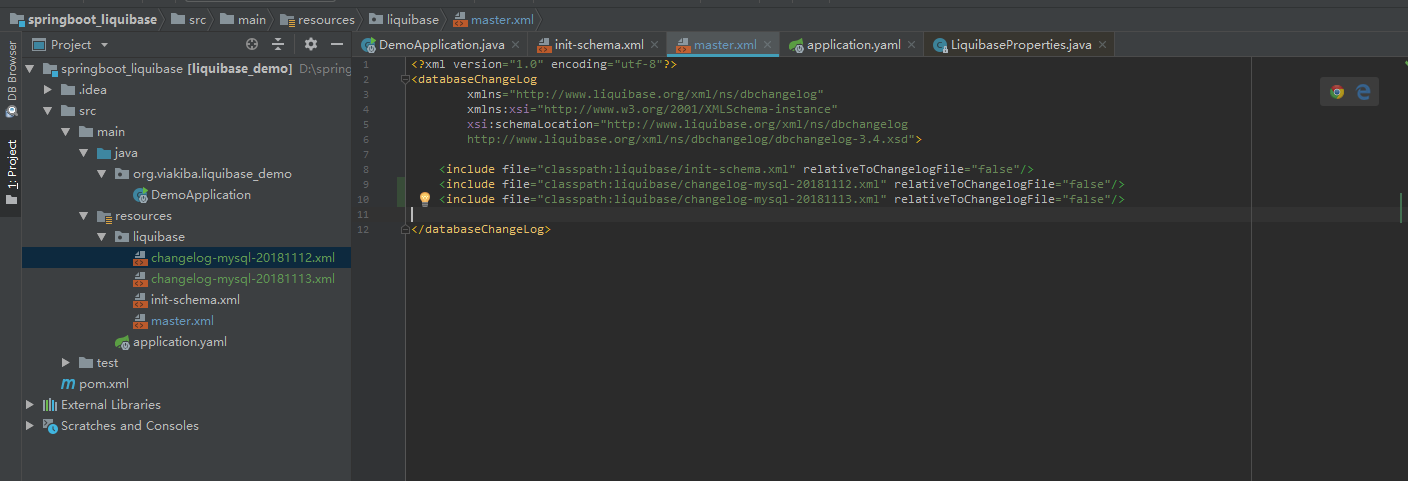概述
liquibase是一个与具体数据库独立的追踪、管理和应用数据库Scheme变化的工具。
特性
- 支持多种数据库类型 如MySQL, PostgreSQL, Oracle, Sql Server, DB2, H2等
- 支持XML、YAML、JSON 与 SQL格式
- 支持上下文相关逻辑
- 支持集群安全的数据库升级
- 生成数据库变更文档
- 生成数据库“diff”
- 穿透构建流程,可根据应用需要嵌入到应用中
-
自动生成SQL脚本,供DBA进行代码审查
- 支持像 Create Table 和 Drop Column 这样的简单命令
- 支持像 Add Lookup Table 和 Merge Columns 这样的复杂命令
- 执行 SQL
-
支持生成与管理回滚逻辑
- 支持多种运行方式,如命令行、Spring集成、Maven插件、Gradle插件等
- 并不能适用于带数据转移,不支持存储过程。
实践
SpringBoot 集成
源代码
liquibase :https://github.com/liquibase/liquibase
参考: http://www.liquibase.org/documentation/index.html
代码地址:https://github.com/viakiba/springboot/tree/master/springbootliquibase
依赖项
<dependency>
<groupId>org.liquibase</groupId>
<artifactId>liquibase-core</artifactId>
<!-- https://github.com/viakiba/springboot/tree/master/springbootliquibase/pom.xml -->
</dependency>
配置项
application.yaml
liquibase:
change-log: classpath:liquibase/master.xml
enabled: true
drop-first: false
change-log
根据上面的配置项可以确定,此时的change-log也就是master.xml </br> 此时,master.xml 作为管理文件,使用
/ 标签对来进行变更文件引入。
如图:

init-scheml
liquibase 是直接支持sql的执行的,所以初始化可以是如下的形式
<?xml version="1.0" encoding="UTF-8"?>
<databaseChangeLog
xmlns="http://www.liquibase.org/xml/ns/dbchangelog"
xmlns:xsi="http://www.w3.org/2001/XMLSchema-instance"
xsi:schemaLocation="http://www.liquibase.org/xml/ns/dbchangelog http://www.liquibase.org/xml/ns/dbchangelog/dbchangelog-2.0.xsd">
<changeSet author="initialDB" id="init-schema" dbms="mysql">
<comment>DB initialization.</comment>
<!--
author: 创建人 会记录到 liquibase 的默认数据表 databasechangelog 中
dbms : 针对的数据库,如果数据源连接的不是mysql,则此脚本不会被执行。如果不指定 则所有数据库类型都会执行。
sql 标签: 里面
-->
<sql>
<!-- 也就是标准 sql 语句 -->
create table if not exists NUSER (
id bigint auto_increment unique,
created_date timestamp,
last_modified_date timestamp,
last_modified_user bigint,
primary key (id)
);
create index last_modified_user_index on NUSER (last_modified_user);
</sql>
</changeSet>
</databaseChangeLog>
也可以是标签的形式
<databaseChangeLog
xmlns="http://www.liquibase.org/xml/ns/dbchangelog"
xmlns:xsi="http://www.w3.org/2001/XMLSchema-instance"
xsi:schemaLocation="http://www.liquibase.org/xml/ns/dbchangelog
http://www.liquibase.org/xml/ns/dbchangelog/dbchangelog-3.4.xsd">
<changeSet id="init-schema" author="initialDB" dbms="mysql">
<!-- 注释 创建表的说明 -->
<comment>DB initialization.</comment>
<!-- 创建表的标签 -->
<createTable tableName="NUSER">
<column name="id" type="bigint" autoIncrement="true">
<constraints primaryKey="true" nullable="false"/>
</column>
<column name="created_date" type="timestamp">
<constraints nullable="false"/>
</column>
<column name="last_modified_date" type="timestamp">
<constraints nullable="false"/>
</column>
<column name="last_modified_user" type="bigint">
<constraints nullable="false"/>
</column>
</createTable>
<!--
<!-- 在 createTable 标签生成的SQL后面 追加 SQL 语句 -->
<modifySql dbms="mysql">
<append value="ENGINE=INNODB DEFAULT CHARSET utf8mb4 COLLATE utf8mb4_general_ci"/>
</modifySql>
-->
</changeSet>
</databaseChangeLog>
master 文件使用 include 标签引入
<?xml version="1.0" encoding="utf-8"?>
<databaseChangeLog
xmlns="http://www.liquibase.org/xml/ns/dbchangelog"
xmlns:xsi="http://www.w3.org/2001/XMLSchema-instance"
xsi:schemaLocation="http://www.liquibase.org/xml/ns/dbchangelog
http://www.liquibase.org/xml/ns/dbchangelog/dbchangelog-3.4.xsd">
<include file="classpath:liquibase/init-schema.xml" relativeToChangelogFile="false"/>
</databaseChangeLog>
liquibase 会产生两个 数据表用于记录当前的数据表 结构情况:
- databasechangelog
- databasechangeloglock
启动
此时服务器启动 后,数据库会出现 databasechangelog / databasechangeloglock / NUSER 三个文件。
常用操作标签
20181112
操作字段
<!-- 新增 -->
<changeSet author="viakiba" id="1" dbms="mysql">
<comment>Add region column in perf_test table.</comment>
<addColumn tableName="NUSER">
<column name="region" type="varchar(255)" />
</addColumn>
</changeSet>
<!-- 更改字段名称 -->
<changeSet author="viakiba" id="12" dbms="h2">
<renameColumn tableName="NUSER"
oldColumnName="region" newColumnName="region_new"/>
</changeSet>
<!-- 更改字段类型 -->
<changeSet author="viakiba" id="14" dbms="h2">
<modifyDataType tableName="NUSER" columnName="region" newDataType="varchar(100)"/>
</changeSet>
操作条件标签
<?xml version="1.0" encoding="UTF-8"?>
<databaseChangeLog
xmlns="http://www.liquibase.org/xml/ns/dbchangelog/1.8"
xmlns:xsi="http://www.w3.org/2001/XMLSchema-instance"
xsi:schemaLocation="http://www.liquibase.org/xml/ns/dbchangelog/1.8
http://www.liquibase.org/xml/ns/dbchangelog/dbchangelog-1.8.xsd">
<preConditions>
<dbms type="oracle" />
<runningAs username="SYSTEM" />
</preConditions>
<changeSet id="1" author="bob">
<preConditions onFail="WARN">
<sqlCheck expectedResult="0">select count(*) from oldtable</sqlCheck>
</preConditions>
<comment>前置条件通过会执行删表操作 expectedResult 是 SQL 执行的预期值</comment>
<dropTable tableName="oldtable"/>
</changeSet>
</databaseChangeLog>
这些标签还有很多没有列出来,可以查看 文档进行业务需求的适应,比如区分 生产与测试等环境 使用 context 标签。比如 配置参数,这个看例子很好理解使用,而且使用很频繁,就不在代码举例了。
基于 Spring 的传统项目
<?xml version="1.0" encoding="UTF-8"?>
<beans xmlns="http://www.springframework.org/schema/beans"
xmlns:xsi="http://www.w3.org/2001/XMLSchema-instance"
xmlns:mvc="http://www.springframework.org/schema/mvc"
xmlns:context="http://www.springframework.org/schema/context"
xmlns:cache="http://www.springframework.org/schema/cache"
xmlns:aop="http://www.springframework.org/schema/aop"
xmlns:tx="http://www.springframework.org/schema/tx" xmlns:util="http://www.springframework.org/schema/util"
xsi:schemaLocation="http://www.springframework.org/schema/beans
http://www.springframework.org/schema/beans/spring-beans-4.3.xsd
http://www.springframework.org/schema/mvc
http://www.springframework.org/schema/mvc/spring-mvc-4.3.xsd
http://www.springframework.org/schema/context
http://www.springframework.org/schema/context/spring-context-4.3.xsd
http://www.springframework.org/schema/aop http://www.springframework.org/schema/aop/spring-aop-4.3.xsd
http://www.springframework.org/schema/tx http://www.springframework.org/schema/tx/spring-tx-4.3.xsd
http://www.springframework.org/schema/cache http://www.springframework.org/schema/cache/spring-cache-4.3.xsd
http://www.springframework.org/schema/util http://www.springframework.org/schema/util/spring-util-4.3.xsd">
<!-- 开启注解配置 -->
<context:annotation-config />
<!-- Use spring servlet for all requests, including static resources -->
<mvc:default-servlet-handler/>
<!-- 开启 @MVC annotations(注解配置) -->
<mvc:annotation-driven />
<!-- 开启 @Controller, @Service... annotations(注解配置) com.yuncanting下的所有层级的包都会被扫描 -->
<context:component-scan base-package="com.yuncanting"/>
<!-- 设置加载properties 配置文件的方式-->
<util:properties id="settings" location="classpath*:param.properties"></util:properties>
<!-- properties配置文件的位置 -->
<bean id="propertyConfigurer" class="org.springframework.beans.factory.config.PropertyPlaceholderConfigurer">
<property name="locations">
<list> <!-- 可以多个 -->
<value>classpath*:param.properties</value>
</list>
</property>
</bean>
<!-- 加载properties key之对应的参数值 -->
<bean id="pooledDataSource" class="com.alibaba.druid.pool.DruidDataSource">
<property name="url" value="${db.jdbcurl}" />
<property name="username" value="${db.username}" />
<property name="password" value="${db.password}" />
<property name="driverClassName" value="${db.driverClassName}"/>
</bean>
<!-- 引入 liquibase **** -->
<bean id="liquibase" class="liquibase.integration.spring.SpringLiquibase">
<property name="dataSource" ref="myDataSource" />
<property name="changeLog" value="classpath:db-changelog.xml" />
<!--
contexts specifies the runtime contexts to use.
-->
<property name="contexts" value="test, production" />
</bean>
<!-- session 工厂 指定mybatis的配置文件的位置-->
<bean id="sqlSessionFactory" class="org.mybatis.spring.SqlSessionFactoryBean">
<property name="configLocation" value="classpath:mybatis.xml"></property>
<property name="dataSource" ref="pooledDataSource" />
</bean>
<!-- 指定 dao 接口的位置 避免实体类的编写-->
<bean class="org.mybatis.spring.mapper.MapperScannerConfigurer">
<property name="basePackage" value="com.yuncanting.dao" />
<property name="sqlSessionFactoryBeanName" value="sqlSessionFactory" />
</bean>
<!-- 事务管理器 -->
<bean id="dataSourceTransactionManager" class="org.springframework.jdbc.datasource.DataSourceTransactionManager">
<property name="dataSource" ref="pooledDataSource"></property>
</bean>
<!-- 指定切面方法的事务方式 -->
<tx:advice id="tx" transaction-manager="dataSourceTransactionManager">
<tx:attributes>
<tx:method name="query*" read-only="true"/>
<tx:method name="*" rollback-for="Throwable"/>
</tx:attributes>
</tx:advice>
<!--事务切面 指定那些方法进行事务管理-->
<aop:config>
<aop:pointcut expression="execution(* com.yuncanting.service.*.*(..))" id="serviceOperation"/>
<aop:advisor advice-ref="tx" pointcut-ref="serviceOperation"/>
</aop:config>
</beans>
总结
liquibase 总之特别适合数据库结构变化迭代较快的开发场景,而且数据库操作方式支持很晚上,目前上面只是举了几个简单的例子,其他项目中需要的操作基本都可以找到,使用的IDE是IDEA时是可以提示的,而且即使没有相关的标签操作,也可以直接写SQL语句操作。